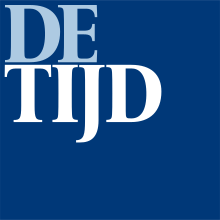De Tijd
 | |
| Type | Daily newspaper |
|---|---|
| Format | Berliner |
| Owner(s) | Mediafin |
| Editor | Stephanie De Smedt |
| Founded | 1968 |
| Headquarters | Havenlaan 86C Box 309 Brussels B-1000 |
| Sister newspapers | L'Echo |
| Website | www.tijd.be |
De Tijd (Dutch: [də ˈtɛit], The Times) is a Belgian newspaper that mainly focuses on business and economics. It is printed on salmon pink paper since May 2009, following the example of its colleagues Financial Times, Het Financieele Dagblad, FT Deutschland and many more.
History and profile
Established under the name of De Financieel-Economische Tijd ("The Financial Economic Times") in 1968,[1][2] in 2003 the paper was renamed as De Tijd.[3]
De Tijd is owned by De Persgroep (50%) and Rossel (50%).[1] The current editor-in-chief of De Tijd is Stephanie De Smedt. It is published in the Dutch language.[2]
De Tijd is a typical financial daily, covering economy and business, financial markets and national and international politics. The paper is the main information source for Belgian managers (CIM-survey 2009). It is published from Tuesday to Saturday[1] with no Sunday or Monday edition. The weekend edition is enriched with two magazines:[1] Netto, on personal finance, and Sabato on lifestyle.
In March 2012 the paper began to be published in Berliner format.[4][5]
De Tijd was named as the Newspaper of the Year in the category of nationwide newspaper by the European Newspapers Congress in 2012.[4]
Mediafin
De Tijd was established and financially supported by the Vlaams Economisch Verbond. In 2005, two major Belgian media conglomerates, the Flemish De Persgroep which is the owner of Het Laatste Nieuws and De Morgen among others and the Walloon Rossel which is the owner of Le Soir among others purchased Uitgeversbedrijf Tijd, the mother company of De Tijd and Editeco, the publishing company of L'Echo, the French counterpart. Both newspapers were integrated in the newly established Mediafin, in which De Persgroep and Rossel each hold a stake of 50 percent.[1][6] Both newspapers stayed independent, but they work in the same building at the historical site of Tour & Taxis in Brussels since the merger. Frederik Delaplace was editorial director of Mediafin.
Circulation
The circulation of De Tijd was 59,144 copies and its market share was 4.7% in 2002.[7] The circulation of the paper was 39,315 copies in 2008 and 36,569 copies in 2009.[8] It was 37,448 copies in 2010, 39,431 copies in 2011 and a total circulation of 41.065 (digital+print) in 2015.[8]
According to the Centrum voor Informatie over de Media, (CIM)[9] De Tijd had a total paid for distribution of 37,031 copies at the end of 2011. It reached 123.300 readers every day. De Tijd had an average market share of 6,4% in Flanders.
The newspaper has been investing in multimedia projects since 2007. The website of De Tijd now reaches about 150.000 unique visitors a day. The website has a (frequency based) paid for model since May 2010.[10] The newspaper is also available via mobile, it has apps for both iPad and iPhone and a html-based app for other tablets.
According to CIM, in 2018–2019, De Tijd recorded 568,700 readers, combining the digital and paper versions.[11]
Slogans
- Het Lijfblad van de Manager (1968–1996).
- Voor kennis van Zaken (1996–2002).
- Uit op Inzicht (2002–2003).
- De Essentie (2003–2006).
- Voor kennis van Zaken (2006–2007).
- Tel mee (2008-2010)
- Voor belangrijke zaken neemt u De Tijd (since 2010)
References
- ^ a b c d e "Belgium Titles". Business Press. Archived from the original on 26 December 2014. Retrieved 4 December 2014.
- ^ a b "European News Resources". NYU Libraries. Archived from the original on 28 January 2015. Retrieved 24 January 2015.
- ^ Pieter Maeseele (2011). "On news media and democratic debate: Framing agricultural biotechnology in Northern Belgium". The International Communication Gazette. 73 (1–2). Retrieved 30 January 2015.
- ^ a b "14th European Newspaper Award" (PDF). Editorial Design. 2013. Archived from the original (Press Release) on 13 March 2016. Retrieved 4 December 2014.
- ^ "New sizes for L'Echo and De Tijd". Adnative. 29 March 2012. Archived from the original on 5 February 2015. Retrieved 5 February 2015.
- ^ Koen Panis; et al. (2014). "Does Media Cross-Ownership Translate into Cross-Promotion?". Journalism Studies. 16 (6): 868–886. doi:10.1080/1461670X.2014.953780. S2CID 147293424.
- ^ David Ward (2004). "A Mapping Study of Media Concentration and Ownership in Ten European Countries" (PDF). Dutch Media Authority. Archived from the original (PDF) on 12 August 2014. Retrieved 12 August 2014.
- ^ a b "National newspapers total circulation". International Federation of Audit Bureaux of Circulations. Retrieved 3 December 2014.
- ^ cim.be (in Dutch and French)
- ^ "Lezersmarkt - mediafin". mediafin.be. Archived from the original on 3 November 2014. Retrieved 15 December 2014.
- ^ "Press audience". CIM (in French). Retrieved 14 July 2020.
External links
![]() Media related to De Tijd (Belgium) at Wikimedia Commons
Media related to De Tijd (Belgium) at Wikimedia Commons
- Official website
- Newspapers in the class room (in Dutch)
- Netto magazine
- Belegger magazine
- Sabato magazine